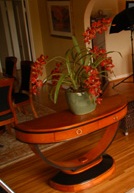Orchids are one of the most architectural plants that look fabulous as an interior element. With a cascade of flowers on each stem and deep green leaves, they are pure in form and light in appearance. Whether you have a traditional home and plant one in blue and white porcelain or a minimalist space and use a low slung matte black planter, orchids will add to your decor. Even if you opt for only a flowering stem in a vase, the bloom can last for months.

1) Use. For elegance, I love to place orchids on a stack of books on a coffee table. I prefer that they 'float' in main rooms so they enhance the furnishings from every angle. For dining rooms, I use them on sideboards and consoles where they are often reflected in mirrors and flanked by wall lighting; I frequently use them to enhance focal points. In a bathroom, they dress up the empty space in tub surrounds and love the humidity. Placed in front of a mirror, they 'double' in size and add drama to your counter. A potted orchid by the bedside is elegant and sensual. Placing an orchid on a kitchen island or peninsula provides a fabulous visual barrier, often between entertaining and dining spaces. On large bookshelves, small orchids nicely soften the linearity. Needless to say, they are wonderful as centerpieces, particularly large or grouped orchids.
 2) Care. Orchids require a special potting mix and not soil; the mix will differ with the type of orchid you select (dendrobium, phalaenopsis, cymbidium, etc...). Roots do not need to be covered fully by the mix and actually love extending out from the pot. An orchid will grow only a few leaves per year, but can bloom multiple times if cared for. Orchids don't like wet feet but love moderate humidity. Generally, they should be watered every 5-8 days, or when the mix is completely dry. Water from the top, allowing the water to flow through the pot. Do not leave soil saturated and never leave standing water at the bottom. When in doubt, it's best not to water. The best light is generally indirect and bright; even a low light orchid needs a period of bright West light and won't thrive in the center of a room. I re-pot my orchids once each year, and only increase the size of the pot - generally one with holes on the sides for best aeration - by one inch. Orchids allowed to acclimate to their pots will do better than those 'swimming' in mix in a too-large pot. With just a bit of attention, your orchid plant will bloom regularly for year-round enjoyment in many spaces in your home.
2) Care. Orchids require a special potting mix and not soil; the mix will differ with the type of orchid you select (dendrobium, phalaenopsis, cymbidium, etc...). Roots do not need to be covered fully by the mix and actually love extending out from the pot. An orchid will grow only a few leaves per year, but can bloom multiple times if cared for. Orchids don't like wet feet but love moderate humidity. Generally, they should be watered every 5-8 days, or when the mix is completely dry. Water from the top, allowing the water to flow through the pot. Do not leave soil saturated and never leave standing water at the bottom. When in doubt, it's best not to water. The best light is generally indirect and bright; even a low light orchid needs a period of bright West light and won't thrive in the center of a room. I re-pot my orchids once each year, and only increase the size of the pot - generally one with holes on the sides for best aeration - by one inch. Orchids allowed to acclimate to their pots will do better than those 'swimming' in mix in a too-large pot. With just a bit of attention, your orchid plant will bloom regularly for year-round enjoyment in many spaces in your home.